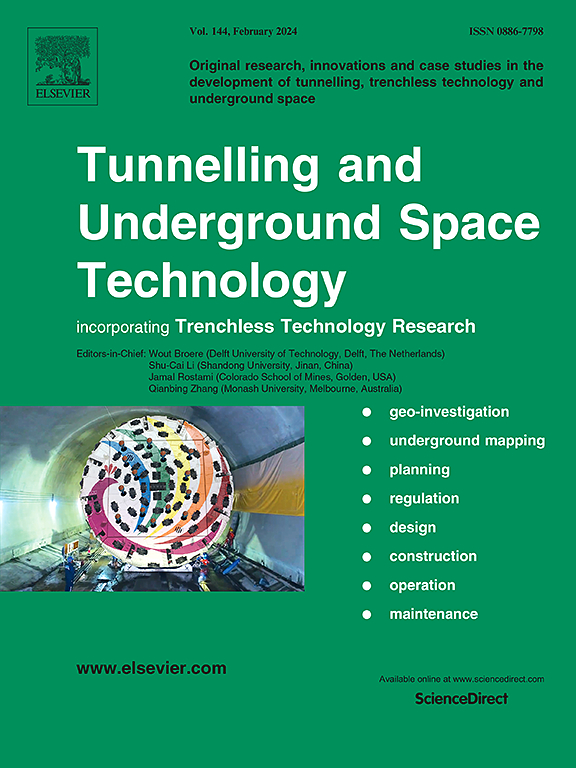基于多源数据融合的复杂螺旋隧道环境对驾驶行为的高动态影响机制
IF 7.4
1区 工程技术
Q1 CONSTRUCTION & BUILDING TECHNOLOGY
引用次数: 0
摘要
螺旋隧道的复杂性加剧了行车安全风险,阐明各种因素的作用机制是开展有效研究的必要条件。基于“道路-驾驶员-车辆”反馈过程,分析了道路线形、照明环境和交通流三个维度对螺旋隧道驾驶员行为和车辆动力学的影响机制。在模拟驾驶实验中控制环境变量进行本研究。首先,分析了螺旋隧道环境中驾驶员视觉和心理行为的变化特征。构建驾驶员认知负荷模型,从驾驶员认知负荷的三个维度对环境因素的影响机制进行比较分析,并量化其耦合权重。其次,建立了引入驾驶员认知负荷外生变量的ARIMAX模型,分析了驾驶员认知负荷对车辆工况的影响。最后,采用LSTM-SHAP模型对车辆运行状态进行多元时间序列预测。从全局和局部两方面解释了模型结构,以评估环境因素对车辆预测结果的影响。结果表明,交通流量(0.01)对驾驶员认知负荷的影响最大,其次是照明条件(0.001),道路线形对驾驶员认知负荷的影响最小(10-5)。驾驶员认知负荷对车辆加速度的影响最大(0.632),其次是车速(- 0.234),车道偏差的影响最小(- 0.185)。环境因素对车辆运行状况的影响与其对驾驶员认知负荷的影响具有相似的趋势。本文章由计算机程序翻译,如有差异,请以英文原文为准。
High-dynamic impact mechanism of complex spiral tunnel environments on driving behavior based on multi-source data fusion
The complexity of spiral tunnels exacerbates driving safety risks, making it essential to elucidate the mechanisms of various factors to conduct effective research in this area. This study, based on the “road-driver-vehicle” feedback process, analyzed the impact mechanisms of three dimensions—road alignment, lighting environment, and traffic flow—on driver behavior and vehicle dynamics in spiral tunnels. Environmental variables were controlled in simulated driving experiments to conduct this study. First, the variation characteristics of driver visual and psychological behavior in spiral tunnel environments were analyzed. A driver cognitive load model was constructed to compare and analyze the impact mechanisms of environmental factors across the three dimensions of driver cognitive load and quantify their coupling weights. Second, an ARIMAX model was developed incorporating the exogenous variable of driver cognitive load to analyze its impact on vehicle operating conditions. Finally, an LSTM-SHAP model was employed for multivariate time series prediction of vehicle operating states. The model structure was explained from global and local perspectives to assess the influence of environmental factors on vehicle prediction outcomes. The analysis revealed that traffic flow (0.01) has the greatest impact on driver cognitive load, followed by lighting conditions (0.001), with road alignment having the smallest effect (10-5). Driver cognitive load has the greatest impact on vehicle acceleration (0.632), followed by speed (−0.234), with lane deviation having the smallest effect (−0.185). The influence of environmental factors on vehicle operating conditions exhibits a similar trend to their impact on driver cognitive load.
求助全文
通过发布文献求助,成功后即可免费获取论文全文。
去求助
来源期刊

Tunnelling and Underground Space Technology
工程技术-工程:土木
CiteScore
11.90
自引率
18.80%
发文量
454
审稿时长
10.8 months
期刊介绍:
Tunnelling and Underground Space Technology is an international journal which publishes authoritative articles encompassing the development of innovative uses of underground space and the results of high quality research into improved, more cost-effective techniques for the planning, geo-investigation, design, construction, operation and maintenance of underground and earth-sheltered structures. The journal provides an effective vehicle for the improved worldwide exchange of information on developments in underground technology - and the experience gained from its use - and is strongly committed to publishing papers on the interdisciplinary aspects of creating, planning, and regulating underground space.
 求助内容:
求助内容: 应助结果提醒方式:
应助结果提醒方式:


